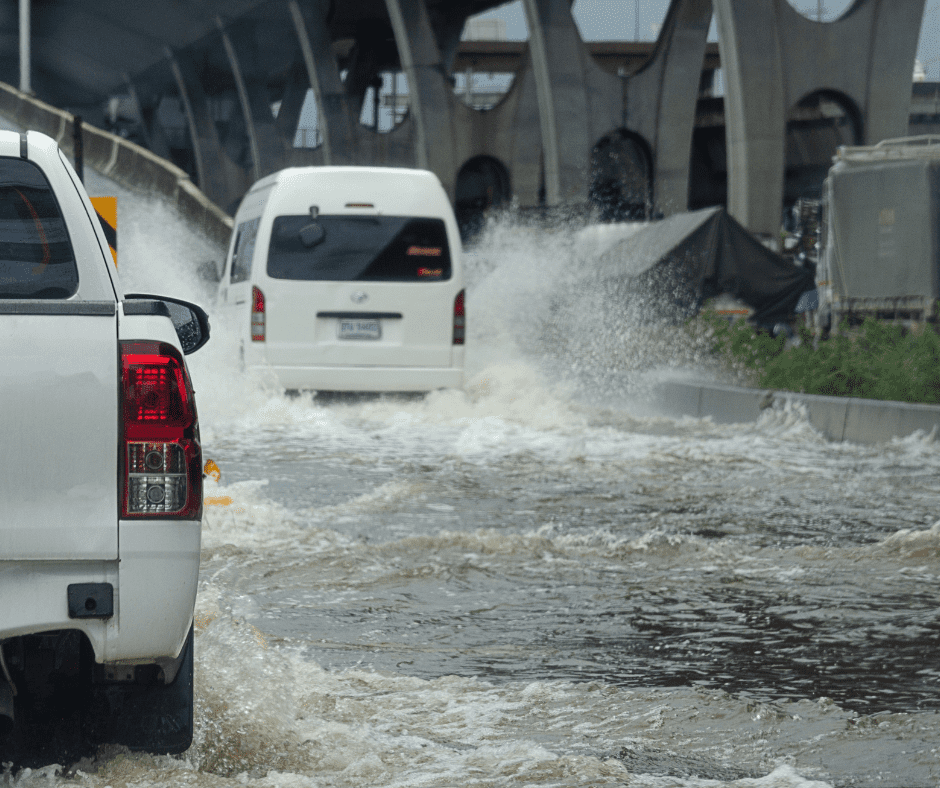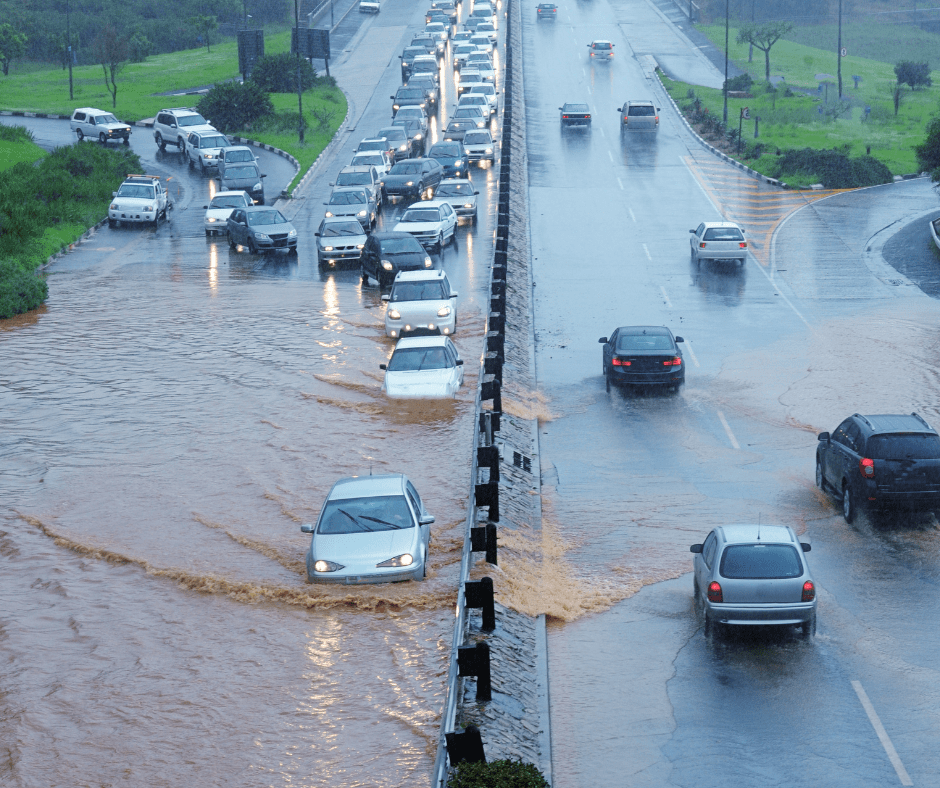How to Stay Safe Driving Through Flooded Roads and Heavy Rain
- Roger Toma
- Blog
- July 18, 2024

The past week has seen Toronto grappling with severe flooding, leaving many drivers stranded on the road and vehicles damaged. The unexpected downpours turned roads into rivers, highlighting the importance of being prepared for driving through heavy rain and floods. With this summer bringing in so much rain, it’s crucial to have the knowledge and tools to safely deal with these challenging road conditions.
The Dangers of Driving Through Deep Water and Flooded Roads
Driving through deep water can be incredibly hazardous. Water can be sucked into the engine, causing severe damage and leading to costly repairs. Vehicles can also lose traction, making them difficult to control, and electrical systems may fail if water seeps into vital components. Moreover, deep water often hides hazards such as submerged objects and road damage, which can lead to accidents or significant vehicle damage. Whenever you come across floodwater, it’s best to avoid driving through it. However, if you find yourself with no other choice, be sure to follow these safety tips.
Tips for Driving Through Flooded Roads
When you encounter a flooded road, it’s vital to proceed with caution. If you must drive through water, follow these steps:
1. Assess the Depth: If you can’t gauge the depth, it’s best not to proceed. Most cars can be swept away in just 12 inches of water.
2. Turn Around, Don’t Drown: If the water appears too deep, find an alternative route. It’s always safer to turn around.
3. Drive Slowly and Steadily: If you must drive through water, do so slowly to avoid creating a bow wave and keep a steady speed to avoid stalling.
4. Stay in the Middle: The centre of the road is typically the highest point. Try to stay in the middle to avoid deeper water near the edges.
5. Avoid Stopping: Keep moving at a consistent pace. Stopping in deep water increases the chance of water entering the exhaust or engine.
1. Assess the Depth: If you can’t gauge the depth, it’s best not to proceed. Most cars can be swept away in just 12 inches of water.
2. Turn Around, Don’t Drown: If the water appears too deep, find an alternative route. It’s always safer to turn around.
3. Drive Slowly and Steadily: If you must drive through water, do so slowly to avoid creating a bow wave and keep a steady speed to avoid stalling.
4. Stay in the Middle: The centre of the road is typically the highest point. Try to stay in the middle to avoid deeper water near the edges.
5. Avoid Stopping: Keep moving at a consistent pace. Stopping in deep water increases the chance of water entering the exhaust or engine.
Checking Your Car for Damage After Driving Through Floodwater
After driving through floodwater, it’s essential to check your vehicle for potential damage. Here’s what you need to do:
1. Inspect the Engine: Check for any water intrusion in the engine bay. If you suspect water has entered the engine, do not start the car. Have it inspected by a professional.
2. Check the Oil: Water in the oil can cause significant damage. Check the oil dipstick for signs of water. If the oil looks milky or diluted, it means water has mixed with it.
3. Examine the Electrical Systems: Water can short out electrical components. Check all lights, indicators, and dashboard warnings to ensure they are functioning correctly.
4. Look for Water Stains: Check the interior for water stains or damp carpets. If the interior is wet, it’s important to dry it out quickly to prevent mold growth.
5. Brake Test: Test your brakes to ensure they are functioning correctly. Wet brakes can lose effectiveness.
6. Check the Exhaust System: Make sure the exhaust system is not blocked or damaged by debris.
7. Inspect the Undercarriage: Look for any damage or debris stuck underneath your vehicle.
1. Inspect the Engine: Check for any water intrusion in the engine bay. If you suspect water has entered the engine, do not start the car. Have it inspected by a professional.
2. Check the Oil: Water in the oil can cause significant damage. Check the oil dipstick for signs of water. If the oil looks milky or diluted, it means water has mixed with it.
3. Examine the Electrical Systems: Water can short out electrical components. Check all lights, indicators, and dashboard warnings to ensure they are functioning correctly.
4. Look for Water Stains: Check the interior for water stains or damp carpets. If the interior is wet, it’s important to dry it out quickly to prevent mold growth.
5. Brake Test: Test your brakes to ensure they are functioning correctly. Wet brakes can lose effectiveness.
6. Check the Exhaust System: Make sure the exhaust system is not blocked or damaged by debris.
7. Inspect the Undercarriage: Look for any damage or debris stuck underneath your vehicle.

Floodwaters can cause significant damage to vehicles. Water entering the engine can lead to hydrolock, rendering the engine inoperable. Electrical systems are particularly vulnerable, and water can short out essential components, leading to expensive repairs. Additionally, wet brakes may lose effectiveness, making it difficult to stop the vehicle safely. During the recent flooding in Toronto, many vehicles stopped working because water infiltrated their engines and electrical systems, causing immediate and severe malfunctions. Regular maintenance and inspections are crucial to minimize these risks, especially in flood-prone areas.
Preventive Measures
To minimize the risk of damage when driving in flood-prone areas, regular maintenance is essential. Ensure your vehicle is in good condition, with a particular focus on brakes, tires, and electrical systems. Plan your routes to avoid low-lying areas prone to flooding, and keep an emergency kit in your car, including a flashlight, first aid kit, and a blanket.
Final Thoughts
Driving through deep water, heavy rain, and floods poses significant risks to both drivers and their vehicles. By staying informed and taking preventive measures, you can navigate these challenging conditions more safely. Remember, when in doubt, it’s always better to find an alternative route and avoid the water altogether. If you’re worried that your car may have been damaged due to the flooding conditions on the road, give us a call or book an appointment, and we would be happy to help.
FAQs on Driving Through Flooded Roads
1. What should I do if my car stalls in deep water? If your car stalls in deep water, do not attempt to restart it. Exit the vehicle if it is safe to do so and seek higher ground. Restarting the engine can cause more damage.
2. How can I tell if a road is safe to drive on during heavy rain? If you cannot see the road surface due to water coverage, it’s best to turn around. Do not attempt to drive through water if you are unsure of its depth.
3. What kind of damage can floodwaters cause to my vehicle? Floodwaters can cause engine damage, electrical system failures, brake issues, and more. It’s crucial to avoid driving through deep water to prevent these problems.
4. Are there any specific signs that indicate my car has water damage? Common signs of water damage include difficulty starting the engine, strange noises, electrical issues, and water stains inside the vehicle. If you suspect water damage, have your car inspected by a professional immediately.



